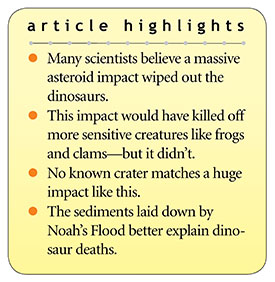 During a recent visit to a church, I told a group of children how and why Noah’s Flood fossilized the dinosaurs. A boy told me he saw a documentary that said an asteroid impact killed the dinosaurs. Did an impact or the Flood kill them? Three science clues help answer this question.
During a recent visit to a church, I told a group of children how and why Noah’s Flood fossilized the dinosaurs. A boy told me he saw a documentary that said an asteroid impact killed the dinosaurs. Did an impact or the Flood kill them? Three science clues help answer this question.
One clue is frogs. An impact powerful enough to demolish thick-skinned, tough, monstrous dinosaurs all over the world surely would have erased thin-skinned amphibians first. The same goes for certain sensitive clams, but that didn’t happen. Frog and clam fossils found near dinosaur bone fossils look the same as today’s frogs and clams.1 Harmful chemicals go right through porous frog skin, and silt chokes clam gills, so how did they survive and not dinosaurs?
Next, where is the impact crater? An impact large enough to wipe out all the world’s dinosaurs should have left a huge, round pit. Most scientists who study this think a region beneath the southern Gulf of Mexico and northern Yucatan Peninsula represents the impact site. However, others disagree for good reasons.
For one thing, the underground feature at that site is not round. Plus, an impact with worldwide destructive force would have melted rocks, but the site has very little melted rock. The rocks down there don’t need an impact to explain them. Magma that rose from the depths could have made the rocks the way we see them today.2 Why should we believe an impact killed the dinosaurs if we can’t find a crater that fills the bill?
Flexible animal tissues still persist inside many fossilized dinosaur bones. ![]()
The size and shape of rock layers give us a third clue that the Genesis Flood, not an asteroid impact, best explains the dinosaur fossils they contain. Each of these rock layers can cover thousands of square miles! A single layer can cover several states. For example, the Hell Creek and Lance Formations were deposited at the same time. They span Montana and Wyoming, plus parts of other states.
How could an impact way down in Mexico deposit this thick layer so far away? An impact should make a wedge-shaped layer, with mud thinning out from the crater. But actual dinosaur layers keep the same thickness for hundreds of miles. Noah’s Flood could do that.
The Bible says that surging Flood waters took months to cover the whole globe. Sure enough, dinosaurs got buried in mud on every continent. And this Flood happened about 4,500 years ago, not 66 million years ago. Science supports this, too. Erosion over millions of years would have carved ruts. Where are the expected ruts between the layers? Instead of erosion ruts, the upper surface of each layer looks flat, as though hardly any time passed before the next layer was laid on top of it by the next huge Flood surge.
Also, flexible animal tissues still persist inside many fossilized dinosaur bones. Blood vessels, hemoglobin proteins, and whole bone cells could never last one million years, let alone 67 million.3 These rocks and fossils look young.
Noah’s recent Flood formed dinosaur fossils fast all over the world. ![]()
Did an asteroid impact kill the dinosaurs millions of years ago? No way. Noah’s recent Flood formed dinosaur fossils fast all over the world.4
References
- Hoesch, W. A. and S. A. Austin. 2004. Dinosaur National Monument: Jurassic Park or Jurassic Jumble? Acts & Facts. 33 (4).
- Clarey, T. L. 2017. Do the Data Support a Large Meteorite Impact at Chicxulub? Answers Research Journal. 10 : 71-88.
- Thomas, B. Best of 2017: Fleshy Fossils. Creation Science Update. Posted on ICR.org December 28, 2017, accessed April 16, 2018.
- Some dinosaurs survived the Flood onboard Noah’s Ark. Genesis 7:15 says that Noah rescued two of every land-dwelling creature with the breath of life in its nostrils, and dinosaurs had legs and nostrils. It appears that the few dinosaurs that lived after the Flood eventually went extinct from habitat loss and hunting. See Thomas, B. 2017. Dinosaurs and Dragon Legends. Acts & Facts. 46 (7): 14-16.
* Mr. Thomas is Science Writer at the Institute for Creation Research and earned his M.S. in biotechnology from Stephen F. Austin State University.




















